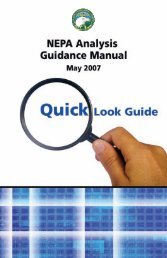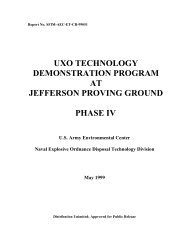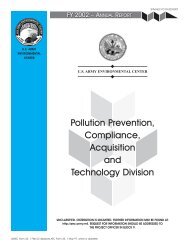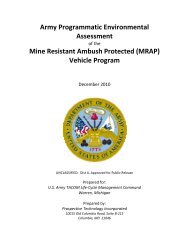range xxi - U.S. Army Environmental Center
range xxi - U.S. Army Environmental Center
range xxi - U.S. Army Environmental Center
You also want an ePaper? Increase the reach of your titles
YUMPU automatically turns print PDFs into web optimized ePapers that Google loves.
FOLLOW-ON PROGRAM REQUIREMENTS<br />
32<br />
POINT OF CONTACT<br />
PROGRAM PARTNERS<br />
PUBLICATIONS<br />
PURPOSE<br />
The ABRP has initiated several new projects through its BAA. The program has<br />
additional field demonstrations ongoing in the following areas:<br />
• Bioremediation of slaughterhouse wastewater using the “Living<br />
Machines” process<br />
• Bioremediation of petroleum, oil and lubricant (POL)-contaminated<br />
soils<br />
• Phytotreatment of contaminated sediments using manufactured soils<br />
• Phytoremediation of explosives-contaminated soils<br />
The University of Hawaii has added summaries of ABRP projects under<br />
its Bioremediation Web site, at http://www2.ctahr.hawaii.edu/<br />
biosystems/bioremediation/.<br />
Program management of the ABRP transitioned to the U.S. Department<br />
of Agriculture in September 2000.<br />
Mark Hampton<br />
U.S. <strong>Army</strong> <strong>Environmental</strong> <strong>Center</strong><br />
U.S. Department of Agriculture<br />
U.S. <strong>Army</strong> Engineer Research and Development <strong>Center</strong>-Waterways<br />
Experiment Station<br />
Tennessee Valley Authority<br />
U.S. <strong>Army</strong>, Pacific. Pilot Compost Facility, U.S. <strong>Army</strong> Garrison, Hawaii,<br />
Schofield Barracks, Final Report. May 1998.<br />
GROUNDWATER EXTRACTION AND TREATMENT<br />
EFFECTIVENESS REVIEWS<br />
The U.S. <strong>Army</strong> spends millions of dollars each year to operate and<br />
maintain major groundwater pump-and-treat systems, but most of the<br />
systems have no defined measures of effectiveness. The Groundwater<br />
Extraction and Treatment Effectiveness Reviews (GWETER) will help<br />
installations determine how well a system is performing, when the system<br />
has reached the end of its usefulness, or whether another method could<br />
meet remediation goals at lower costs.<br />
To institute an <strong>Army</strong>wide program for developing clear remediation<br />
objectives and measures of effectiveness for planned and installed<br />
groundwater pump-and-treat systems. For systems where remedial<br />
objectives cannot yet be obtained, the program will reevaluate and<br />
renegotiate the objectives using risk-based approaches and reasonable landuse<br />
scenarios.







